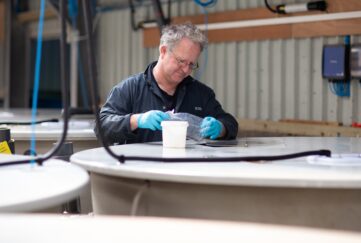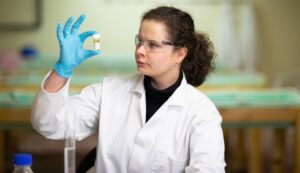Thirty years of MERL

The Institute of Aquaculture’s Marine Environmental Research Laboratory has played a key role in the development of aquaculture over three decades
For three decades, the Marine Environmental Research Laboratory (MERL) has been at the vanguard of aquaculture research and innovation.
Part of the University of Stirling’s world-leading Institute of Aquaculture (IoA), the coastal facility near Campbeltown on the Kintyre peninsula hosts a wide range of academic and contract commercial research.
IoA’s vision is to tackle global problems of food security, hunger and sustainability through aquaculture and our work was recognised with the award of the prestigious Queen’s Anniversary Prize.
We have an international reputation for our teaching, world-class research, technological innovation, and consultancy in aquaculture.
MERL has played a huge part in cementing that reputation. The laboratory provides large scale facilities for experimental studies on fish in seawater and a range of research resources, including live cultures of commercially important pathogens.
The University’s ongoing commitment to MERL was recently underlined with a £2m refurbishment which began earlier this year.
MERL was opened 30 years ago by the then Chief Scientist to the Cabinet Office, Professor William Stewart, and Professor Arthur John Forty, who was Principal and Vice-Chancellor of the University of Stirling.
It took 18 months to develop MERL’s complex facilities at Machrihanish, a site chosen for its high-quality Atlantic seawater. The facility would go on to revolutionise marine aquaculture.
Former MERL director Dr Derek Robertson, who worked at the facility for more than two decades, said: “The impact of MERL for the aquaculture industry was enormous.
“Most of the licensed drugs in use for salmonid aquaculture worldwide were trialled at MERL, and marketing licenses secured using the data from these trials.
“Products were successfully developed for control of sea lice; novel feeds and vaccines were created; and MERL was also largely responsible for the development of the farmed cod industry in Scotland.
“MERL went on to pioneer the commercial development of cleaner fish technology using ballan and goldsinny wrasse, work which has led to very extensive academic research by IoA staff into all aspects of cleaner fish technology.
“The most important research project MERL participated in during my time there was the testing and trial of Schering-Plough’s Slice product, the first licensed sea lice therapeutic.
“The late Janet Stone and Professor Chris Sommerville pioneered the technique for cultivating sea lice and then developed reproducible challenge techniques which formed the foundation for all sea lice challenge trials that followed.
“It is no exaggeration to say that the Scottish aquaculture industry would not be as successful as it is today without MERL’s pioneering involvement.”
Thirty years on, MERL’s staff and facilities are still the natural first choice for academic, commercial, and public research partners across the globe.
Professor Simon MacKenzie, head of the University of Stirling’s Institute of Aquaculture, said: “We are all very proud of MERL, its history, the fantastic people involved across the years and its legacy as a standout landmark in aquaculture research and development.
“We are delighted with the investment to take MERL to further support the Institute in developing the next level of cutting-edge research, teaching and innovation in our ambitious new strategy.”

MERL has an international reputation for world-class research and technological innovation
Cutting-edge research
Dr Armin Sturm’s work at MERL has sought to understand and monitor sea lice resistance against treatments. Studies carried out at MERL have contributed to improving sea louse management by defining genetic markers for resistance monitoring. Moreover, knowledge of the mechanisms of resistance provided the basis for the development of medicines less prone to drive resistance development.
Dr Sturm said: “At MERL, the different well-characterised salmon lice strains maintained in culture were key to the above research projects. Staff at MERL further contributed to designing and carrying out sea lice crossing experiments where the parentage of each individual is known, which is an essential requirement for genetic mapping approaches used in the studies.”
Dr Susan Fitzer’s research at MERL examined the mixed effects of pH, temperature, and feeding regime on carbon sequestration and shell growth. The aim of this research was to identify the pathways of carbon uptake into the shells, and the potential resultant changes in shell mechanical properties using an experimental approach.
Dr Fitzer said: “MERL provided the essential laboratory facilities to enable the experimental culture of mussels and oysters under laboratory simulated ocean acidification and warming scenarios. The staff including Simon Barnett and Chessor Matthew, were instrumental in their support during experimental culture ensuring mussels and oysters were cared for during the two-month long experiments.”
Professor Bret Glencross has examined how environment and nutrition interact to affect fish performance. Experiments were run at MERL where diets with different levels of long-chain omega-3 were fed to fish under either hypoxic (low oxygen) or normoxic (normal oxygen) conditions.
Additional variables of diet lipid level and ration were also introduced in the two different experiments. The work led to revisions of dietary recommendations for levels of omega-3 in diets for salmonids being made by major suppliers of omega-3 resources.
Professor Glencross said: “The facilities and expertise at MERL were critical to these two projects. Each experiment ran over four months and required daily monitoring and management of the fish, feeding systems and water oxygenation control. This latter facet was particularly challenging, as it meant round-the-clock management of the system. The staff at MERL were crucial in not only the operation of these trials, but also their design, ensuring that four world-class experiments were delivered.”

The Marine Environmental Research Laboratory (MERL) at Machrihanish, near Campbeltown on the Kintyre peninsula
MERL capabilities
MERL has 125 flow-through and recirculation tanks, ranging from 0.1 to 13 cubic metres, which are equipped with environmental monitoring, automatic feeding systems, feed recovery, and a liquid oxygen supply. There is also a dedicated quarantine facility.
Seawater can be filtered, sterilised and temperature controlled. Several experimental systems of up to 36 identical tanks are available for replicate trials. Systems can be built to meet requirements for size, water quality, feeding, lighting and other variables.
MERL manager Chessor Mathew said: “We maintain Atlantic salmon on site for trials aimed at improving salmon and trout aquaculture in Scotland and around the world, and we will always consider new species, assays, and challenge models. As part of the University of Stirling’s Institute of Aquaculture, we have access to a wide range of academic collaborators.”
MERL Senior Technician David Basset added: “We can help companies and academic groups design, plan and cost an experiment. We have staff who can assess the welfare of the fish, collect and analyse data, and write up reports that are ready to be submitted to regulators.”


